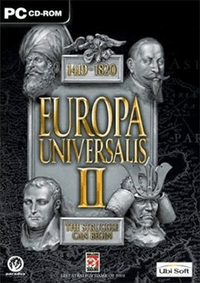Europa Universalis II
| Europa Universalis II | |
|---|---|
 Cover art of Europa Universalis II | |
| Developer(s) | Paradox Development Studio |
| Publisher(s) | Strategy First MacPlay Typhoon Games |
| Engine | Europa Engine |
| Platform(s) | Windows Mac OS Mac OS X |
| Release date(s) |
|
| Genre(s) | Grand strategy |
| Mode(s) | Single player Multiplayer |
| Distribution | 1 CD-ROM |
Europa Universalis II is an empire-building, strategy video game based on European and world history spanning a timeline between 1419 through 1820. It was developed by Paradox Development Studio.
Gameplay
In the game, the player controls a single nation across many centuries, managing its economy, military, political alliances, scientific development, exploration and colonization, religious affairs, and internal stability. In addition, yearly random events, as well as hundreds of pre-scripted ones based on the historical record, make for a great deal of gameplay challenge and variety.
Europa Universalis II differs from many similar turn-based strategy games in that time flows continuously during gameplay, rather than taking place in discrete turns. The player is able to pause the action to ponder the situation and give orders, then speed up or slow down time to let events take their course.
The game ships with several historical scenarios, including games that take place during the Age of Exploration, the American Revolution, and the Napoleonic Wars. The Grand Campaign lets players choose one world power and guide it from the end of the Middle Ages and into the 19th century. There is also a Fantasy Scenario, starting in an unoccupied and unexplored earth with only 8 civilizations to choose. In this scenario, casual gameplay and strategy that should be applied are slightly different, more like a 4X game with a strong emphasis on colonization.
While the Grand Campaign is geared primarily towards the major European powers of the time, such as Austria, England, France, Poland, Portugal, Russia, Spain, Sweden, and Ottoman Empire, the game is unique in that players can choose to play as one of more than a hundred obscure, no longer existing nations, from the Indian subcontinent to the Balkans.
Game modding
The game goes into a great deal of granular detail, including urban populations for each of the hundreds of provinces, thousands of historical monarchs, generals, and explorers, as well as names for colonies, armies, and fleets.
In addition, with almost all of the game data stored in easy-to-edit text files, Europa Universalis II is easy to modify and customize, which has yielded a large and thriving mod community. Players have been able to create new flags, maps, units, historical events, leaders and even entire scenarios.
It is also possible to play a campaign beginning with Crusader Kings, followed by Europa Universalis II, Victoria (or Victoria II) and finished with Hearts of Iron II: Doomsday, allowing for campaigns to range from 769 to 1954. This is by using the in-built features of these games that convert a saved campaign to the chronologically-next Paradox title.
The popular mod AGCEEP was used as the basis for the fan-made standalone expansion For the Glory in 2009.[1]
Publishing History
The game was developed by Paradox Interactive as a sequel to Europa Universalis, and was first released for the PC in 2001 by Strategy First, with a Macintosh port created by Virtual Programming and published by MacPlay. As of 2009, a Linux port is on its way.[2]
Asia chapters
A version of the game, called Europa Universalis II: Asia Chapters, was released for Asian markets, adding new graphics and scenarios that center around Asian history instead. It featured an updated map with greater detail and added provinces in Japan, Korea, and China.
References
- ↑ For the Glory Announcement, Paradox Forums Retrieved 2011-09-08.
- ↑ "An Interview With A Linux Game Porter". Phoronix.
External links
- Europa Universalis II Official wiki
- Europa Universalis II at Paradox Interactive
- Europa Universalis II at MobyGames
- Europa Universalis II at DMOZ
| ||||||||||||||||||||||||||
| ||||||||||||||||||||||